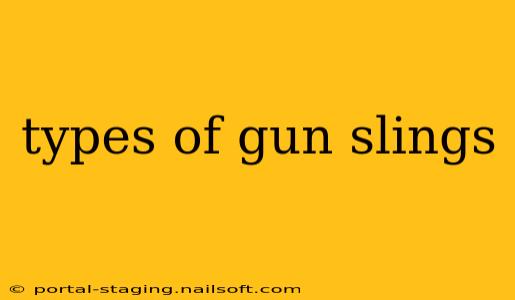Choosing the right gun sling can significantly enhance your shooting experience, improving comfort, stability, and overall performance. But with so many types available, understanding the nuances of each is crucial. This guide explores various gun sling types, highlighting their strengths and weaknesses to help you make an informed decision.
Understanding the Importance of a Gun Sling
Before diving into the specifics, let's establish why a gun sling is essential. A well-chosen sling offers several key advantages:
- Enhanced Carry: Reduces fatigue during long periods of carrying your firearm, particularly in challenging terrain.
- Improved Stability: Provides a steadier shooting platform, leading to greater accuracy.
- Quick Deployment: Allows for faster access to your firearm in emergency situations.
- Versatile Carry Options: Offers various carry methods, adapting to different situations and shooting styles.
Main Types of Gun Slings: A Detailed Breakdown
Several types of gun slings cater to different needs and preferences. Let's examine some of the most popular:
1. Single-Point Slings
- How it works: Attaches to a single point on the firearm, usually the rear sling swivel. This allows for a quick transition from a carry position to a shooting position.
- Pros: Simple design, easy to use, ideal for quick access.
- Cons: Can be less stable than other sling types, might not be suitable for all shooting styles. Can restrict movement if not adjusted properly.
- Best for: Law enforcement, tactical situations, close-quarters combat (CQB).
2. Two-Point Slings
- How it works: Attaches to two points on the firearm (usually front and rear sling swivels). This provides greater stability and multiple carry options.
- Pros: More stable than single-point slings, offers various carry methods (e.g., across the chest, across the back, tactical), more comfortable for long periods of carrying.
- Cons: Can be slightly more complex to adjust compared to single-point slings.
- Best for: Hunting, long-range shooting, hiking, general recreational shooting.
3. Three-Point Slings
- How it works: Incorporates three attachment points – two on the firearm and one on the shooter's body (often a chest-mounted attachment). This allows for a secure and stable carrying position and facilitates quick transitions.
- Pros: Exceptionally stable, keeps the firearm close and secure, allows for hands-free carrying.
- Cons: Can be more complex to adjust and use, requires additional equipment (chest mount).
- Best for: Tactical applications, law enforcement, competitive shooting requiring rapid transitions.
4. Padded Slings
- How it works: Features padded sections that distribute weight and increase comfort, especially during extended periods of carrying.
- Pros: Improved comfort, reduces shoulder strain, ideal for heavier firearms.
- Cons: Can be bulkier and heavier than non-padded slings.
- Best for: Long-distance hiking, hunting trips with heavy firearms.
5. Adjustable Slings
- How it works: Allows the user to adjust the length of the sling to perfectly fit their body and the specific shooting situation.
- Pros: Versatility, crucial for customization and comfort.
- Cons: Requires proper adjustment for optimal performance.
- Best for: All sling types benefit from adjustable features.
Choosing the Right Sling: Key Considerations
Selecting the appropriate sling depends on several factors:
- Type of firearm: The weight and dimensions of your firearm influence sling choice.
- Intended use: Tactical applications demand different features than hunting or recreational shooting.
- Personal preference: Comfort and ease of use are subjective.
By understanding the various types of gun slings and considering your specific needs, you can select the perfect accessory to enhance your shooting experience and ensure safe and comfortable firearm handling. Remember to always practice safe firearm handling techniques and consult relevant regulations.
